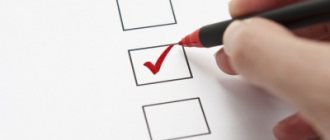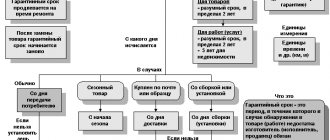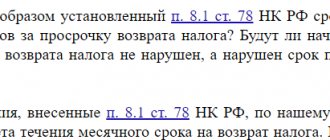Home / Complaints, courts, consumer rights
Back
Published: September 25, 2018
Reading time: 9 min
0
658
A cash receipt is a primary fiscal document confirming the completion of a retail purchase and sale transaction or the purchase of a specific service. Upon payment of the required amount, the check is printed by the seller (cashier or other employee responsible for this) on a cash register machine, after which it is handed over to the buyer.
- Cash receipt: main functions and the need for availability in a controversial situation
- Obligation to issue a cash receipt
- Possible actions in case of non-issuance of a check Preventive measures
- Procedure
- Making a claim
- Direction of the complaint, result and possible further actions
However, in some situations, issuance is not carried out, which, depending on a number of factors, can be either a legal or illegal action of the seller.
Is the seller required to provide a receipt document upon purchase?
The requirement to issue cash register receipts to customers and clients is enshrined in the Federal Law of May 22, 2003 No. 54-FZ “On the use of cash register equipment (CCT) when making cash payments and (or) payments using payment cards.”
Issuing a check is considered the seller's responsibility and otherwise is punishable by administrative liability .
Control over compliance with cash discipline is carried out by the inspection of the Federal Tax Service and Rospotrebnadzor.
How to create a product database at the checkout
So, to create a product database at the checkout, there are the following options for entering items:
Uploading from an Excel or CSV file via your personal cash register account.
You create a table with goods in a file using a certain template, go to your personal cash register account via your PC and download this file according to the instructions. Your cash desk support staff probably has instructions on how to do this.
Entering each item manually into the online cash register, one by one.
Open a catalog (or directory) of goods at the checkout. You create cards for each product and manually fill in all the fields provided there. This method, of course, is not as fast as the first. But it’s quite suitable if you need to add just a few items to the catalog.
By the way, MTS Cashier has its own global product directory (GTS) built into it. Therefore, even filling out the catalog one by one is very fast. You just need to scan the barcode of a new product, the cash register will “pick up” it from the GTS and fill out all the fields for you. The cashier will only have to indicate the VAT rate, the quantity of goods and its price.
Loading from the inventory system.
This method is for those who decided to immediately take the bull by the horns and, together with the nomenclature, establish goods accounting. The method is very similar to the first, only you add goods not in your personal cash register account, but directly in the goods accounting service.
You need to select a product accounting program in advance and connect it to the cash register with a specialist. Goods from technical specifications are transferred automatically to the cash register.
As for MTS Cashier, there is no need to connect the goods accounting service separately. It is already built-in and available in your personal account. Therefore, if you decide to switch to balance accounting a little later, it is already at your disposal.
Loading goods from electronic invoices.
This is worth reading if you sell labeled products or alcohol. Modern cash services are integrated with EDI and EGAIS. When accepting electronic invoices, the service recognizes the new position, automatically adds a card to it and puts it on the balance sheet.
Exactly which methods of creating a product database your cash register supports depends on its cash register program.
In what cases is it not issued and is it not considered a violation?
In accordance with paragraph 2.1 of the second article of the Federal Law of May 22, 2003 No. 54-FZ, an organization or individual entrepreneur has the right not to issue a cash receipt in the case of paying the Unified Tax on Imputed Income or in the case of using a patent taxation system. This permission applies only to organizations providing services to individuals and does not apply to law firms and organizations.
In addition, the right to not issue a cash receipt to the buyer applies to the following types of activities :
- sale of newspapers, papers and lottery tickets;
- sale of travel tickets;
- organization of catering within the enterprise;
- small retail trade from hand;
- acceptance of glass containers and waste materials;
- sale of goods in religious organizations and churches;
- charity;
- care services for the elderly and disabled.
In all other cases, including a breakdown of the cash register, failure to issue a cash receipt is a violation and faces an administrative fine.
In the event of a malfunction of the cash register, the seller is obliged to issue a special form indicating the amount, name of the product or service, as well as the name of the organization with the date and signature of the seller.
After eliminating the malfunction, the seller is obliged to record the transaction and clear the outstanding receipt. Otherwise, the action will be regarded as an attempt to evade paying tax and will be punishable by an administrative fine.
Why issue checks?
Before the advent of self-employment in Russia, many residents worked illegally. For example, tutors provided training services and did not pay taxes. Opening an individual entrepreneur was profitable only with large volumes of orders. And if a self-employed person worked at school at the same time, there was little time left for part-time work.
The government decided not to organize tax audits, but to help people get out of the shadows as painlessly as possible and work legally without problems with reports, payment of taxes, and fines. The experiment ended successfully and officials decided to make it part of the tax legislation.
In August 2021, the Federal Tax Service reported that, thanks to self-employment, it was possible to bring 130 billion rubles out of the shadows. During the entire period of the tax experiment, citizens paid more than 3.5 billion rubles in taxes. On a national scale, this is not a huge figure, but previously the money did not reach the budget.
Self-employment was created with a focus on maximum simplicity. Any citizen with a Taxpayer Identification Number (TIN) and a passport can register as a professional income tax payer. You don’t even need authorization on the government services portal; you can download the “My Tax” application and fill out the form in it.
Self-employed people do not have tax reporting like individual entrepreneurs or LLCs. They create receipts for transactions in the application and the data is automatically sent to the Federal Tax Service after the end of the reporting period. If you wish, you can even set up automatic tax write-off if you link a bank card to the application.
In 2021, new self-employed people were given a 10,000 ruble tax deduction, which could be used to pay tax on professional income. There were no such privileges this year, and unused bonuses for last year were canceled in January 2021.
The principle of self-employed people working with clients is as simple as possible. Let's assume that there is a blacksmith Ivan who makes metal products to order. A large company approaches him with a large order. Ivan enters into an agreement with a legal entity and issues a check for each payment.
Legal entities pay individuals by transfer to a current account. They can only pay by bank transfer, so in this case they cannot do without the help of a bank. You can also cooperate with individuals using electronic payment systems.
The company prepares an agreement, Ivan signs and expects an advance payment. The need to report to the tax authorities arises for Ivan when funds arrive in his account and he fulfills his obligations to clients. According to current legislation, a self-employed person is required to generate a check after receiving money from a client.
For non-cash payments, a check must be generated and submitted no later than the 9th day of the month following the tax period in which the transaction was carried out. If you violate the deadlines, the counterparty may complain to the Federal Tax Service and sanctions will follow.
A check is a confirmation of the income of the professional income tax payer. Some self-employed people make payments several days before the end of the reporting period, but it is better to do this on the day the funds are received or the next.
Firstly, you don’t have to spend a lot of time on financial accounting right away. You can create a payment receipt in 2-3 minutes, but if you accumulate 200-300 of them in a month, it will take at least half a day to work with the application. Secondly, the legislative acts clearly define the working mechanism.
Many self-employed people have many questions about online cash registers. In the case of non-cash payments with individuals and legal entities, it is not needed. It is enough to generate a check in the application, send it to the counterparty and make sure that at the end of the month the “My Tax” interface contains the correct income figures.
One of the main mistakes of self-employed people is that they do not keep financial records in third-party applications and services. You must use Excel, CRM or financial accounting applications. There are many tools on the market to solve this problem.
If you keep records somewhere else, at the end of the reporting period it will be possible to compare the numbers and eliminate errors. For example, if several clients refused the service and had to return the money, the self-employed person may forget about voiding checks.
And if he keeps records in Excel or CRM and deletes the transaction immediately after the refund, the numbers will differ from the data in the “My Tax” application. Therefore, an extra source of information definitely won’t hurt and will help protect against problems. If a self-employed person forgets to cancel a check and the reporting goes to the tax office, it will be more difficult to eliminate the error.
Self-employed citizens must reflect payments for goods and services in the “My Tax” application because this is the only way to inform the tax office about how much money is passing through their accounts.
Potential self-employed residents of the Russian Federation often ask whether they need to create checks when they are on sick leave or going on a long vacation. In this case, there is no need to work with the “My Tax” application. If there is no income temporarily, then checks are not needed.
Perhaps changes will soon be made to the legislative framework , and self-employed people will be required to close each month manually and confirm that they had no income, but this is not the case yet. We can say that the tax office trusts NAP payers and gives them freedom of action.
Although monitoring systems closely monitor all self-employed people. Therefore, we do not recommend underestimating the numbers in checks or entering only half of the receipts into applications. There is no doubt that the bank accounts of all self-employed people are under special control.
For example, if a self-employed person spends 100,000 rubles a month through “My Tax”, and the turnover exceeds 500,000 rubles, the Federal Tax Service will sooner or later have questions. NAP payers are rarely invited to a reconciliation, but if this happens, the inspector may schedule a personal meeting.
If an individual has documents to confirm the origin of the funds, there will be no problems. For example, if a person simultaneously works for a company and receives a salary, he will be able to provide documents from the employer.
Penalties for violation of reporting rules
The conversation with malicious violators who do not spend money from their professional activities through “My Tax” is short. According to current legislation, if you do not issue a check to the client on time, there will be a fine of around 20% of the settlement amount.
Let’s say a counterparty transferred 100,000 rubles to the account for a month of tutor services. But the self-employed person did not give him a check and forgot to make a payment through the “My Tax” application at the end of the reporting period. It is difficult to prove malicious intent, but there is a prescribed legislative framework that determines the procedure for punishment.
Self-employed people will be charged 20% of the order value. Obviously, no one wants to lose a fifth of the amount. Especially if we are talking about large payments within the framework of ongoing cooperation, and not one-time transactions.
For a repeated violation, the tax service will impose a fine in the amount of the full amount of the calculation. The Federal Tax Service website has a special form for complaints against self-employed people. If the client leaves a request, the probability of receiving a fine increases to 100%. Therefore, it is better not to delay in generating the check and make sure that the counterparty receives it.
If at the time of generating a receipt there is a technical failure in the My Tax application, you can create it after the repair work is completed. Typically, normal database operation is restored the next business day. In this case there will be no sanctions.
Can I replace it with other documents?
Starting from July 1, 2021, replacing a cash receipt with any other document, including a cash register or receipt, will be illegal and considered an administrative violation, regardless of the type of activity of the company and the nature of the services provided. Most often, such forms are used by private organizations engaged in small retail trade or providing various services in the field of beauty, mortgage insurance, veterinary services, etc.
The strict reporting form must include the following items:
- series and form number;
- legal address of the company;
- TIN;
- name and cost of the service or product;
- nature of payment (cash or bank transfer);
- date of transaction;
- Full name of the person who performed the transaction;
- seller's signature.
What has changed with the advent of online cash registers?
Sellers registered before the adoption of the new version of Law No. 54-FZ have the right to issue a sales receipt instead of a cash receipt. Such sellers include, in particular, individual entrepreneurs and legal entities that pay UTII. The option for them not to use online cash registers remains until July 1, 2021, after which they will be required to switch to modern technologies that simplify document flow. It is important to understand that a sales receipt will not be an alternative to a cash receipt - in the modern formulation of the law, the first concept is completely absent.
Consequences of absence for the buyer
If for an organization failure to issue a cash receipt threatens with an administrative fine and other penalties from the tax authorities, then for the buyer or client there are other risks.
The presence of a receipt is a guarantee of receipt and provision of services , with a clearly indicated amount and date of the transaction. This means that in the event of any claims to the quality of the product, the buyer is protected by the “Consumer Rights Protection Law”, and the fact of payment and receipt of the service is easily proven. Such a check protects both the buyer and the seller from unfounded claims.
We can say that a cash receipt guarantees protection from the law in cases provided for by Russian legislation.
If the product is of poor quality, having a receipt gives you the right to return or replace it. If a poor-quality service is provided and there are unpleasant consequences, it will be much easier to receive monetary compensation and prove the case in controversial situations.
If there are witnesses at the time of purchase, and the surveillance camera is turned on, the product can be returned . Another thing is that this process is long and energy-consuming. A cash receipt simplifies this procedure for both parties.
Electronic boarding pass
Include payment for travel for business travelers in tax expenses based on a printed electronic ticket or boarding pass (letter of the Ministry of Finance No. 03-03-06/1/4908 dated January 28, 2020).
If an electronic ticket is lost, the flight costs will be confirmed by a certificate from the airline that the business traveler flew on the flight indicated on the ticket. If there is no certificate, the Ministry of Finance allows you to justify the expenses with a ticket and documents indirectly confirming the flight (letter of the Ministry of Finance No. 03-03-05/12957 dated February 28, 2019) - a mark in the passport, etc.
Collection
The balance of funds in excess of the established cash limit must be deposited with the bank. This is called collection. Entrepreneurs and organizations have several options for collection:
- Concluding a collection agreement with the bank. It will cost 500-800 rubles per trip and from 0.1% to 2% of the collected amount.
- Self-collection at a bank branch - depositing money into a current account independently through a bank branch;
- Self-collection via ATM
- An electronic cash collector is a special safe that is located on the premises of an organization. Cash is deposited into it, which is subsequently credited to the current account. This safe is also collected by the bank, but with less frequency.
Collection through a branch and ATM will cost less than regular collection by a bank: approximately 0.3% of the deposited amount. The maintenance of an electronic cash collector costs the same.
Self-collection does not guarantee security, but it is cheaper and much more flexible in time, which is very important for businesses with a small number of employees.
There are several features of issuing wages to employees from the cash register
Salary payments are made according to payroll statements (or simply payroll statements). They indicate:
- date of issue;
- amount issued;
- person to whom wages are paid.
Sample pay slip
These statements are compiled for all employees and then sent to the accountant, who makes the payments themselves. In this case, a single expenditure cash order is drawn up, which indicates the amount of all funds issued.
In addition, there is a separate procedure for issuing cash to accountable persons and payments by proxy.
Accountable persons receive money from the cash register for the needs of the organization or individual entrepreneur. For example:
- tickets for business trips;
- expenses for housing on business trips;
- purchasing supplies for the organization.
The employee must report for the money received within three days after the deadline for which the money was issued. For this purpose, an advance report is prepared. Receipts or strict reporting forms confirming the fact of expenditure are attached to the advance report.
It is usually prohibited to bring foreign currency into the cash register. The only exception is the deposit of currency into the cash desk for the issuance of travel allowances to an employee going abroad. Accordingly, returning excess foreign currency to the cash desk after a business trip will not be punished.
Payments by proxy are used if the receiving person is unable to receive the money on their own. The receiving person can send his representative in his place to collect the payment. But for this, the representative must have a power of attorney. After payment, this power of attorney is attached to the reporting documents (RKO, statement).
Note: Despite the fact that money is the property of the enterprise, even its owner cannot simply take it from the cash register for his own needs. To do this, the entrepreneur must first deposit them into the current account and withdraw them. An exception is for individual entrepreneurs on the simplified tax system - they can take funds for personal purposes against an expense cash order.
What can you spend money on directly from the cash register?
| Entrepreneurs, organizations |
|
| Financial organizations and pawn shops. Consumer cooperatives (credit and agricultural) |
|
What kind of money can you spend directly from the cash register?
You can spend cash on the purposes indicated in the table from:
- activities of the enterprise;
- from insurance premiums;
- for the second group in the table – loan payments, fines and penalties on loans;
- from share contributions (for cooperatives).
Where does the seller get his phone number?
The seller or service provider can use only those contacts (phone number, email) that he received from the consumer to transfer the check. This means that you left contact information when placing an online order or application on the site, and thereby consented to the processing of this data to send a check.
The seller, therefore, transfers your subscriber number to the automatic cash register and OFD systems - to send a fiscal document, and then the check is sent to your subscriber number, where it arrives in the form of a service message on behalf of the store, or on behalf of the OFD (depending on whether the store has set its brand name in the electronic receipt or not).










